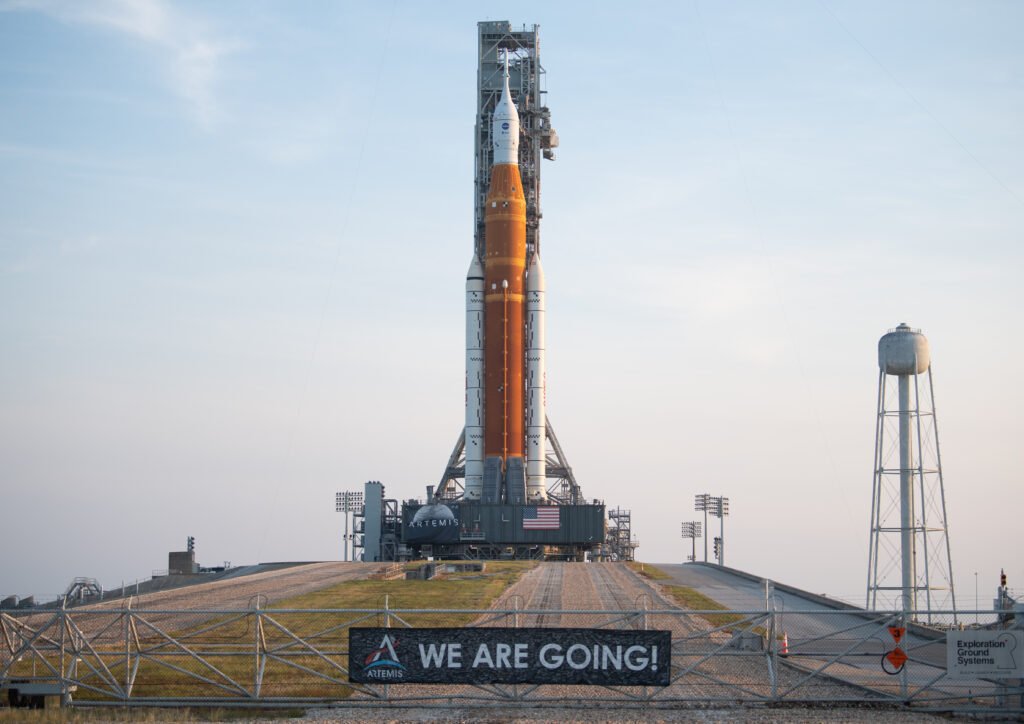WE ARE HEADING TO MOON AGAIN.
On Monday, the most powerful rocket that NASA has ever constructed is scheduled to lift off from the Kennedy Space Center in Florida on its way toward a rendezvous with the moon. This launch, which the space agency is billing as a major step toward returning humans to the surface of the moon for the first time in half a century, will take place in a mission that is being billed as a giant leap.
A 30-story-tall Space Launch System (SLS) rocket was rolled out earlier this month to the same historic launch complex that was utilised by the mighty Saturn V during the Apollo moonshots that ended in 1972. Atop the SLS rocket is an uncrewed Orion spacecraft. Preflight procedures for the SLS are currently being carried out by engineers, and if everything goes according to plan, a final countdown and liftoff will take place on Monday morning sometime.
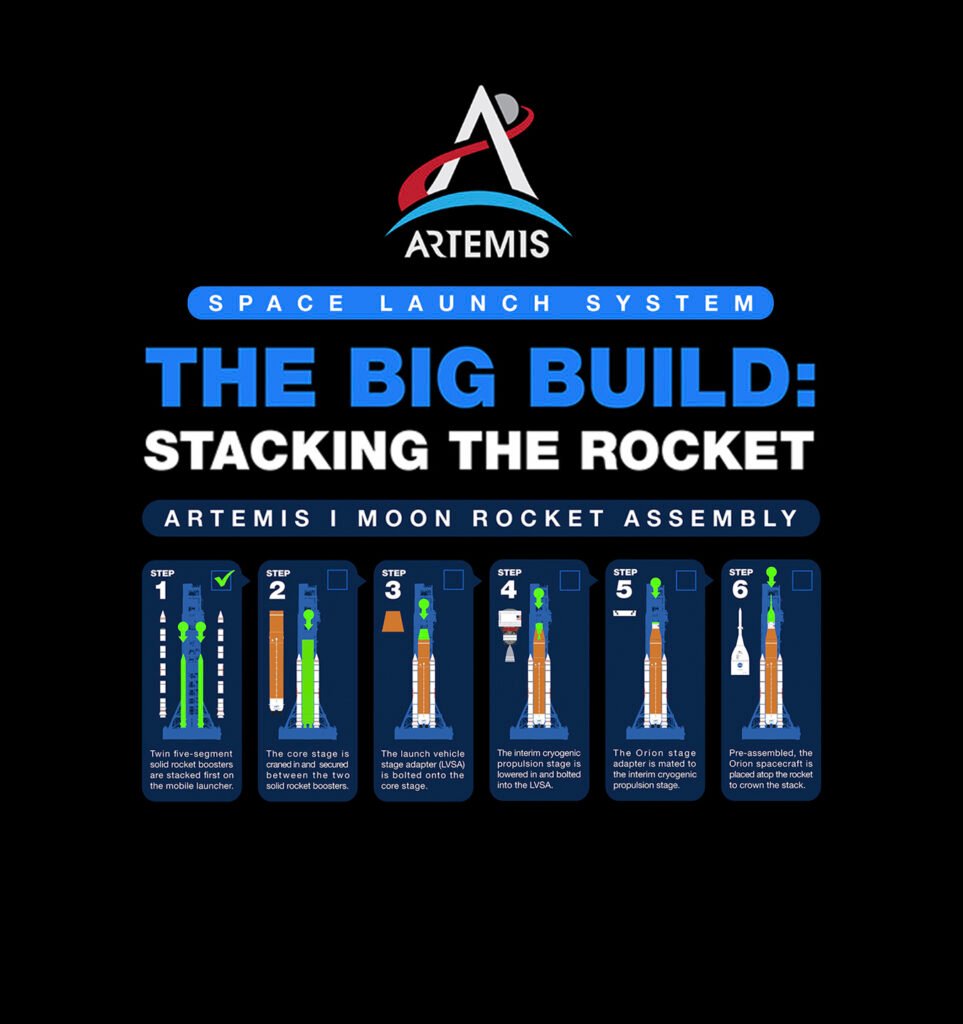
The very first mission of Artemis, which was given the name of Apollo’s twin sister, Artemis, is a test run of the necessary hardware in order to return to the moon for extended stays and additional scientific research.
During an interview on NPR’s All Things Considered, NASA astronaut Nicole Mann stated that “it is an incredible step for all of humankind.” “This time, we’re going to settle down on the moon. In addition to that, it serves as the foundation for our future exploration of Mars.”
NASA’s Artemis programme has the ability to realign the agency’s long-term human space-flight objectives, opening the door to projects such as a manned base near the moon’s south pole and manned flights to Mars. The eventual cost of the Artemis programme is anticipated to be $93 billion.
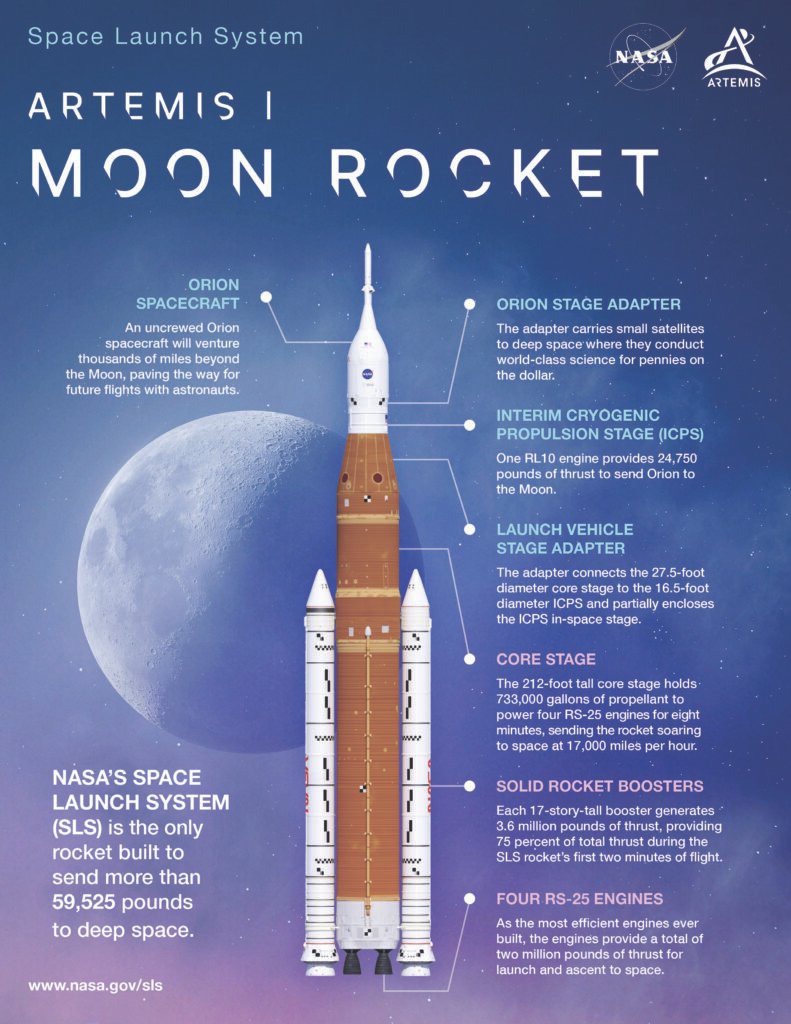
However, a significant component of the programme, the vehicle that will be used to actually land on the moon, will not be included in the initial Artemis mission. SpaceX, which is owned by Elon Musk, has been awarded a contract to create a lunar variation of their Starship to transport astronauts to the lunar surface; however, this vehicle has not yet been evaluated in space. Gateway is another component of the original Artemis programme that is still in the process of being developed. Gateway is intended to function as a kind of deep-space way station for astronauts travelling to and from a future moon base.
WITH A RETRO LOOK, HERE COMES A CONTEMPORARY MISSION.
The Space Launch System (SLS) is equipped with extending versions of the solid-rocket boosters that were previously used by the space shuttle, which completed its final flight more than a decade ago. Additionally, the SLS is powered by four RS-25 engines that have been reconditioned and are being reused after having previously flown on shuttle missions. The upper stage of the rocket will be propelled by a specific kind of engine that was initially designed in the late 1950s.
The SLS core stage and upper stage are both being built by Boeing, the SLS’s primary contractor. According to Noelle Zietsman, chief engineer for the Space Launch System (SLS) programme at Boeing, in order to construct the enormous rocket, engineers drew inspiration from the “foundations and fundamentals” of the Saturn V and space shuttle eras.
She continues, “We’ve got our missions that we’re focused on right now to the moon,” and she is referring to the lunar exploration missions. “But, [the SLS] is intended for use in exploration of deep space… Therefore, the capability is significantly greater and more larger beyond than simply landing on the moon.”
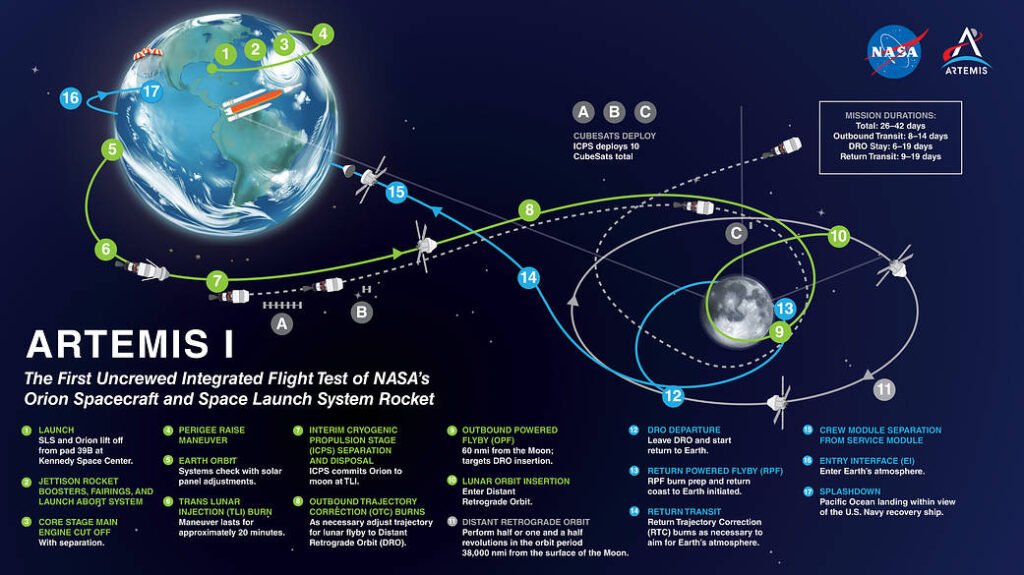
The cone-shaped Orion spacecraft, which will take as many as four men into lunar orbit on future missions, is reminiscent of the “command module” that was used during the Apollo programme. Last but not least, a European service module will be added to Orion. This module will be analogous to Apollo’s service module in terms of its functions and will offer future crews with propulsion, energy, water, oxygen, and climate control.
NASA Administrator Bill Nelson said earlier this month “When you look at the rocket, it almost looks retro,” . “But it’s a totally different, new, highly sophisticated, more sophisticated rocket and spacecraft.”
Orion will be placed into what is known as a remote retrograde orbit throughout the course of the six-week test flight that will be conducted by Artemis I. This orbit is an oblong circuit that will take it just 62 miles from the surface of the moon at one time and far beyond the moon at another.
Mike Hawes, Orion programme manager at Lockheed Martin, which is producing the capsule, said that on Artemis I, the Orion will fly without life support equipment, some crew support items, or a docking system because none of these things are required for the first mission.
Three dummies fitted with radiation and vibration detectors will stand in.
Hawes says, “Getting the radiation profile and having a long exposure in this unique lunar orbit is really important to us as we get ready to fly crew,”
In 2024, NASA intends to send four humans into space on the Artemis II spacecraft. The following year, in 2025, Artemis III is scheduled to make the program’s maiden landing. According to the space agency, the initiative will eventually make history by sending a woman and a person of colour to the moon for the first time. However, Artemis and its predecessor, Constellation, have been plagued for years by delays as well as cost overruns.
According to a report that was released by the NASA Inspector General the previous year, the space agency was expected to “beyond its schedule” for the first Artemis moon landing “by many years.”
Following liftoff, Artemis I will reach low-Earth orbit, and then Orion’s service module will unfold its solar panels before launching itself into a higher orbit in order to get ready for a journey to lunar orbit that will take four days.
ARTEMIS COULD PLAY A KEY ROLE IN GETTING TO MARS.
NASA has high hopes that, during a future landing, they will be able to extract water ice that has been confirmed to exist deep within polar craters that never receive sunlight. This water ice is an essential resource that can be used for drinking, producing oxygen that is breathable, and eventually producing rocket fuel. The moon’s low gravity would make it much easier to launch crewed expeditions to Mars if there was already a base on the moon. This would make a lunar base a crucial stepping stone toward reaching Mars.
NASA has just lately stated that thirteen locations close to the moon’s south pole are in the running for the Artemis III surface mission that will take place in a few years. These spots have been selected because they are simple to touch down in, they are exposed to sunlight, which allows a spaceship to create solar power, and they are in close proximity to probable ice formations that are constantly shaded.
David Kring, a lunar geologist at the Center for Lunar Science & Exploration in Houston, Texas. says “The lunar south pole is an absolutely extraordinary geologic terrain,” “We are going to learn so much about the evolution of the moon.”
Further he adds – “When we better understand the evolution of the moon, we are going to be better understanding the evolution of our own planet Earth,”
However, a mission to the polar regions will be something quite different. This is a break from the Apollo programme, which stationed a dozen astronauts at locations that were all located closer to the moon’s equator.
Bethany Ehlmann, associate director of the Keck Institute for Space Studies at the California Institute of Technology says – “The topography looks a bit more remarkable at the south, just because the sun angle is so low.
Ehlmann is the leader of a group that is responsible for the robotic mission known as Lunar Trailblazer, which is scheduled to take place the following year and will provide detailed maps of those persistently shadowed crater locations that have the potential to store ice.”
In comparison to the Apollo landing sites located closer to the equator, “the terrain is comparable” in the south pole.
NASA’s ARTEMIS BASE CAMP
Beginning with the Artemis III mission, humans will set foot on the moon’s surface for the first time this century. The lunar South Pole will be the first location on the Moon’s surface to be visited by humans, and it will be done by two astronauts who will take the first new journey to the surface of the Moon from lunar orbit. Given the proximity of this area to ice and other material resources, it would make an excellent choice for the site of a future base camp.
The human landing system will also serve as lunar lodging for the initial few flights, providing the necessary life support systems for a crew to remain on the Moon for a limited amount of time. NASA has plans to construct a permanent habitat at the Artemis Base Camp in the not too distant future. This habitat will have the capacity to accommodate up to four astronauts for a period of one month.
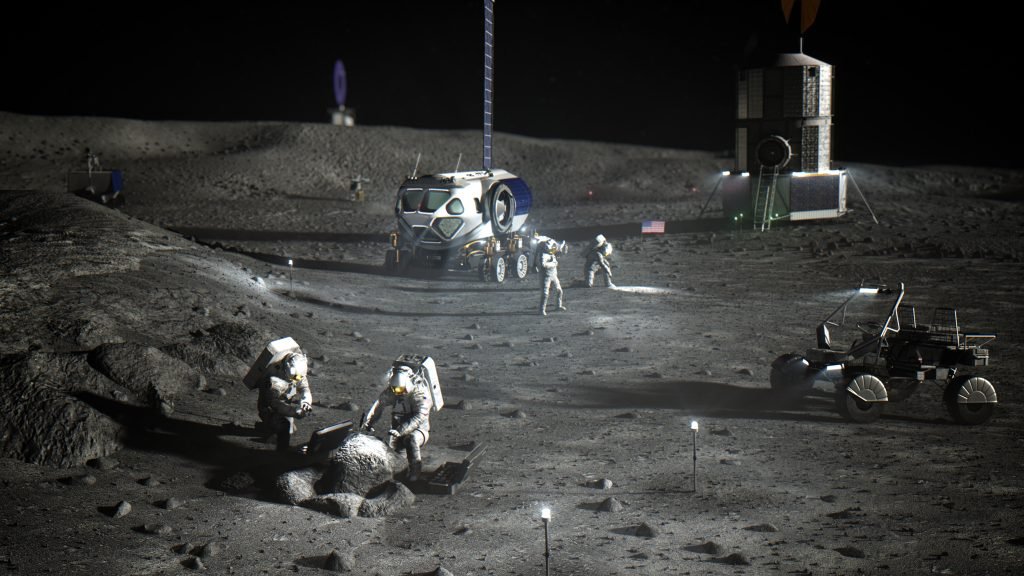
WHAT WILL THEY WEAR
Even though there would only be limited surface assistance available for the initial flights, astronauts will nevertheless be expected to proceed on at least a week-long journey on the Moon. The crew will perform their duties during the day while wearing their cutting-edge spacesuits. They will use cutting-edge gear to collect samples and set up a variety of studies.
These next-generation spacesuits will enable greater mobility and a more powerful life support system than their Apollo ancestors did. Modern communications technology will also be included. Because of the increased crew’s usefulness and mobility, they are now able to conduct more complicated investigations and collect more distinctive geology materials.
NASA is currently in the process of developing new lunar landing suits and plans to hand over design and manufacturing responsibilities to the private sector for subsequent production runs.
KEEP A NOTE
Solar power prospects are almost unabated thanks to the fact that the Sun always appears to be in the same general location in the sky over the lunar South Pole, both during the day and throughout the year. However, there is not a single region on Earth that does not experience periods of nighttime. This means that NASA needs to make preparations for early Artemis systems to survive in an extremely cold environment without power, and they need to build in the capability to store electricity for up to eight days at a time.
The Lunar Surface Innovation Initiative of NASA is collaborating with the Departments of Energy and Defense of the United States to develop a nuclear fission surface power unit for longer-term work trips to the Artemis Base Camp. This unit will be able to continuously provide 10 kW of power, which is equivalent to the amount of power that a typical home in the United States uses in one year.
This small power plant will be capable of powering and recharging the other fundamental components of the Artemis Base Camp, as well as allowing for greater flexibility in the planning of missions by reducing the necessity of having continuous access to sunlight in a specific location during a predetermined window of time.

